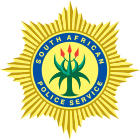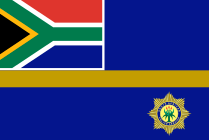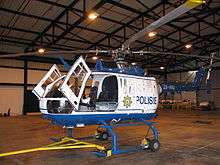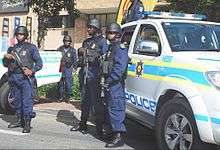South African Police Service
| South African Police Service | |
|---|---|
 South African Police Service badge | |
 South African Police Service flag | |
| Agency overview | |
| Formed | 1995 |
| Preceding agencies |
|
| Employees | 193,692 (2014/15) |
| Jurisdictional structure | |
| National agency | South Africa |
| Operations jurisdiction | South Africa |
| Size | 1,219,090 km2 |
| Population | 53,491,133 (2015 est) |
| Constituting instruments |
|
| General nature | • Local civilian agency |
|
| |
| Officers | 150,950 (2014/15) |
| Civilians | 42,792 (2014/15) |
| Minister of Police responsible | |
| Agency executive |
|
| Divisions |
6
|
| Provincials |
9
|
| Facilities | |
| Stations | 1,138 (2014/15) |
| Website | |
|
www | |
The South African Police Service (SAPS) is the national police force of the Republic of South Africa. Its 1,138 police stations in South Africa are divided according to the provincial borders, and a Provincial Commissioner is appointed in each province. The nine Provincial Commissioners report directly to the National Commissioner. The head office is in the Wachthuis Building in Pretoria.[1]
The Constitution of South Africa lays down that the South African Police Service has a responsibility to prevent, combat and investigate crime, maintain public order, protect and secure the inhabitants of the Republic and their property, uphold and enforce the law, create a safe and secure environment for all people in South Africa, prevent anything that may threaten the safety or security of any community, investigate any crimes that threaten the safety or security of any community, ensure criminals are brought to justice and participate in efforts to address the causes of crime.[2]
Amnesty International and others have expressed serious concerns about South African police brutality, including torture and extrajudicial killings.[3][4][5][6][7]
History
The South African Police Service traces its origin to the Dutch Watch, a paramilitary organisation formed by settlers in the Cape Province in 1655 to protect civilians and to maintain law and order. In 1795, British officials assumed control over the Dutch Watch, and in 1825 established the Cape Constabulary (which became the Cape Town Police Force in 1840). In 1854, a police force was established in Durban which would become the Durban Borough Police, and in 1935 the Durban City Police (DCP).[8] Act 3 of 1855 established the Frontier Armed and Mounted Police Force in the Eastern Cape, restyled as the Cape Mounted Riflemen in 1878.[9]
The South African Police (SAP) was created after the establishment of the Union of South Africa in 1913. Four years later, the Mounted Riflemen's Association relinquished its civilian responsibilities to the SAP as most of its riflemen left to serve in the First World War. The SAP and the military maintained a close relationship even after the SAP assumed permanent responsibility for domestic law and order in 1926. Police officials often called on the army for support in case of emergencies. During the Second World War, one SAP brigade served with the 2nd Infantry Division of the South African Army in North Africa.
When the National Party (NP) edged out its more liberal opponents in nationwide elections in 1948, the new government enacted legislation that strengthened the relationship between the police and the military. Police subsequently became heavily armed, especially when facing unruly or hostile crowds. The Police Act (No. 7) of 1958 broadened the mission of the SAP beyond conventional police functions, and allowed police to quell civil unrest and conduct counterinsurgical operations. The Police Amendment Act (No. 70) of 1965 allowed police to detain any person, receptacle, vehicle, aircraft, or premise within one mile of any national border, and to seize anything found without a warrant. This search-and-seize zone was extended to within eight miles of any border in 1979 and to the entire country in 1983.
After the end of apartheid, the South African Police was renamed the South African Police Service (SAPS), and the Ministry of Law and Order was renamed the Ministry of Safety and Security, in keeping with these symbolic reforms. The new Minister of Safety and Security, Sydney Mufamadi, obtained police training assistance from Zimbabwe, the United Kingdom and Canada and proclaimed that racial tolerance and human rights would be central to police training in the future. By the end of 1995, the SAPS had incorporated the ten police agencies of the former homelands, and had reorganised at both national and provincial level.
Organisation

Three police unions were active in bargaining on behalf of police personnel and in protecting the interests of the work force, as of 1996. These are the Police and Prisons Civil Rights Union, which has about 150 000 members; the South African Policing Union (SAPU), which has about 35,000 members; and the Public Service Association (PSA), which has about 4,000 members.
Divisions
South African Police Service headquarters in Pretoria is organised into six divisions: the Crime Combating and Investigation Division, the Visible Policing Division, the Internal Stability Division, the Community Relations Division, the Supporting Services Division, and the Human Resource Management Division.
The Crime Combating and Investigation Division holds overall responsibility for coordinating crime and investigative procedures. It administers the Criminal Record Centre, Commercial Crime Unit, Diamond and Gold Branch, Narcotics Bureau, Stock Theft Unit, the Inspectorate for Explosives, murder and robbery units located in each major city, and vehicle theft units throughout the country. In addition, the division manages the National Bureau of Missing Persons, which was established in late 1994. The Visible Policing Division manages highly public police operations, such as guarding senior government officials and dignitaries. Most government residences are guarded by members of the division's Special Guard Unit. The division's all-volunteer Special Task Force handles hostage situations and other high-risk activities. The Internal Stability Division is responsible for preventing and quelling internal unrest, and for assisting other divisions in combating crime. The Community Relations Division consults with all police divisions concerning accountability and respect for human rights. The Supporting Services Division manages financial, legal, and administrative matters. There is also a large reserve division.
Rank structure
The current ranking system of the South African Police Service was adopted in April 2010.[10] The change caused some controversy as new ranks like "general" and "colonel" have a military connotation. Furthermore, the new rank system mirrors the system used by the South African Police during the apartheid era. In 2009, Deputy Minister of Police Fikile Mbalula spoke of making the police a paramilitary force by changing the SAPS ranking system so that it would closely mirror the military ranking system. This created a significant amount of controversy from people critical of what they called the "militarisation" of the police.[11][12][13]
National commissioners
|
|
Resources
Vehicles
Through the early-1990s, the police were equipped with smoke and tear-gas dispensing vehicles, tank trucks with water cannons, vehicles that dispensed barbed wire or razor wire to cordon off areas, and a number of rotor and fixed wing aircraft for surveillance, ground force management, rapid deployment of Task Force and specialist teams to crime scenes and VIP personnel movements.
Aviation

The South African Police Service operate a fleet of 45 aeroplanes and helicopters.
|
Aircraft
|
Helicopters
|
Firearms

South African Police Service officers generally carry a Vektor Z88 9mm pistol (although a more compact pistol, the RAP 401, is available) and pepper spray. Officers in Cape Town are equipped with Glock 17s. Each patrol car is usually also equipped a R5 rifle. To quell disturbances a variety of firearms are used, including R1 semi-automatic rifles, BXP sub-machine gun, Musler 12 gauge shotgun (capable of firing anti-riot rubber bullets contained in standard 12 bore shotgun cartridges), as well as tear gas and pencil flares. The R1 rifle has been withdrawn from all front-line police armories since the mid-1990s, but is still used by elements of the Special Task Force.
Criticism and controversies
Administration
Since the departure of democratic South Africa’s first National commissioner George Fivaz in January 2000, a number of successive commissioners have been unable to complete a single term in office, most implicated in and charged with misconduct.[14][15]
The distribution of personnel has been controversial, with local legislators questioning why areas most in need of policing resources are being neglected.[16] The department was criticised by the Western Cape Government for providing the lowest number personnel (adjusted for population) with a shortage of 2,392 officers,[17] despite having the highest murder rate.[18][19] This has been the subject of the Khayelitsha Commission.
Brutality and repression
Amnesty International has expressed concerns about police brutality, including torture and extrajudicial killings, in South Africa.[20][21][22][23][24][25] There has also been concern about brutal training methods for the police.[26] According to Peter Jordi from the Wits Law Clinic "[Police] Torture is spiralling out of control. It is happening everywhere."[27] Brandon Edmonds argues that "The cops prey on the poor in this country."[28] Independent studies have confirmed that the SAPS has been used to repress peaceful marches.[29] In April 2009, SAPS attempted to ban unFreedom Day[30] and was implicated in support for September 2009 ANC mob that attacked the elected leadership of the shack settlement at Kennedy Road, Durban.[31][32][33] Police officers have also been accused of excessive policing in Blikkiesdorp in Delft, Cape Town, by suppression of freedom and ordering illegal curfews.[34][35][36]
630 police officers from Gauteng Province were arrested in 2011, for fraud and corruption but also rape and murder.[37] An April 2012 editorial in The Times opined: "It seems torture and outright violation of human rights is becoming the order of the day for some of our police officers and experts warn that the line between criminals and our law enforcement officers is "blurred"."[38]
In February 2013, police in Daveyton, Gauteng were caught on video brutalising Mido Macia, a Mozambican taxi driver accused of parking illegally. Macia was handcuffed to a police van and dragged through the streets, later succumbing to his injuries.[39] Eight police officers were arrested.[40]
Marikana massacre
The Marikana Massacre,[41] was a mass shooting that occurred when police broke up a gathering by striking Lonmin workers on a 'koppie' (hilltop) near the Nkaneng shack settlement in Marikana on 16 August 2012. 34 miners were killed and 78 miners injured, causing anger and public outcry, fueled by reports that most of the victims were shot from behind[42] and many shot far from police lines.[43] It later emerged that the violence had actually started on 11 August when leaders from the National Union of Mineworkers opened fire on striking NUM members killing two.[44] It is alleged that police did nothing in the aftermath thereby creating a situation in which workers felt that they would have to use other means to protect themselves.[45] Between the 12 and 14 August, approximately 8 more people were killed including two policemen and two security guards.[46] It is the country's deadliest incident between police and the civilian population since the Sharpeville Massacre of 1960, and has been referred to as a turning-point in post-1994 South Africa.[47][48][49]
Corruption
On 10 September 2007 an arrest warrant was issued by the National Prosecuting Authority (NPA) for National Police Commissioner Jackie Selebi (Interpol president from 2004 to 2008). On 23 September 2007, President Mbeki suspended NPA Head Vusi Pikoli, allegedly because of "an irretrievable breakdown" in the relationship between Pikoli and Justice Minister Brigitte Mabandla. However, journalists at the Mail and Guardian claim to have solid information supporting the widespread suspicion that President Mbeki suspended Pikoli as part of a bid to shield Police Commissioner Selebi.[50] According to the Mail and Guardian on 5 October 2007 the NPA was investigating Selebi for corruption, fraud, racketeering and defeating the ends of justice.[50] Selebi was found guilty of corruption in July 2010, but not guilty of further charges of perverting the course of justice.[51]
In February 2011 Bheki Cele was implicated in unlawful conduct and maladministration with a R500m lease agreement for the new police headquarters in Pretoria.[52] In October 2011, President Jacob Zuma announced that Cele had been suspended pending an investigation into the agreement.[53] After recommendation from a board of inquiry, Zuma dismissed Cele and announced that Riah Phiyega, the first female commissioner, would replace him.[54]
See also
References
- ↑ "Contact Us ." South African Police Service. Retrieved on November 21, 2017. "SAPS Head Office Wachthuis Building 231 Pretorius Street Pretoria[...] GPS Coordinates: S25.74790 E28.18901"
- ↑ SAPS: PROFILE – Vision and Mission
- ↑ No end in sight for police brutality in South Africa, Justice Malala, The Guardian, 21 February 2013
- ↑ South Africa, the police state of Brutality, Humiliation, Impudence, The Daily Maverick, 1 March 2012
- ↑ Footsoliders in a social war: the police, crime and inequality in South Africa CHRISTOPHER MCMICHAEL, Open Democracy, 25 October 2013
- ↑ Police brutality comes as a surprise? Really?, Pierre de Vos, Daily Maverick, 1 March 2012
- ↑ Amnesty International South Africa Report, 2012
- ↑ Newham, Gareth; Themba Masuku and Lulama Gomomo. "Metropolitan Police Services in South Africa, 2002". csvr.org.za. Retrieved 8 August 2009.
- ↑ McCracken, Donal P (1991). "The Irish in South Africa – The Police, A Case Study (Part 20)". Irish Times. Retrieved 8 August 2009.
- ↑ http://www.saps.gov.za/org_profiles/NEW_RANK_STRUCTURE_WEB.pdf
- ↑ The professor and the police minister. Paul Trewhela, 25 October 2009
- ↑ Asmal: Militarisation of police is "craziness" Mail & Guardian, 19 October 2009
- ↑ Green Zone Nation: The South African government’s new growth path, Open Democracy, 19 March 2012
- ↑ Khaas, Tebogo (2017-11-05). "Black Monday: We are going backwards". News24. Retrieved 6 November 2017.
- ↑ editorials (2017-10-27). "Top cop position is a poisoned chalice". The Citizen. Retrieved 6 November 2017.
- ↑ VAN DER MERWE, Marelise (8 April 2016). "Beyond Khayelitsha: Just how unequal is distribution of police in South Africa?". Daily Maverick. Retrieved 10 October 2016.
- ↑ "Western Cape's police shortage receiving 'lots of attention' – top cop". News24. Retrieved 2016-10-10.
- ↑ "Public hearings to be held over police shortages in Western Cape". News24. Retrieved 2016-10-10.
- ↑ Knoetze, Daneel (26 August 2014). "Highest crime areas have fewest cops - Khayelitsha commission". Ground Up. Retrieved 10 October 2016.
- ↑ Amnesty red flag police brutality, Craig Dodds, 13 May 2011
- ↑ Amnesty International South Africa Report 2011
- ↑ See for instance this statement by Abahlali baseMjondolo
- ↑ "Housing and Evictions at the N2 Gateway Project in Delft". Abahlali baseMjondolo. 8 May 2008.
- ↑ "Video of Delft shootings on eTV". YouTube. 19 February 2008.
- ↑ "Pictures of Delft evictions and police brutality". Anti-Eviction Campaign. 22 February 2008.
- ↑ Police training: Brutality exposed, KAMVELIHLE GUMEDE-JOHNSON, MAIL AND GUARDIAN, JOHANNESBURG, SOUTH AFRICA – 3 June 2011]
- ↑ 'Predator police' in reign of terror GRAEME HOSKEN, The Times, 30 April 2012
- ↑ The New Toyi Toyi, Brandon Edmonds, Mahala, 12 May 2012
- ↑ See, for instance, a report on illegal police repression in South Africa by the Freedom of Expression Institute
- ↑ "UnFreedom Day 2009". Libcom.
- ↑ "'Attackers associated with ANC'". News24.
- ↑ "The Attacks Continue in the Presence of the Police and Senior ANC Leaders". Abahlali baseMjondolo.
- ↑ "Joint Statement on the attacks on the Kennedy Road Informal Settlement in Durban". Professor John Dugard SC, et al. Archived from the original on 18 October 2013.
- ↑ Smith, David (1 April 2010). "Life in 'Tin Can Town' for the South Africans evicted ahead of World Cup". London: The Guardian Newspaper.
- ↑ "Somalis harassed and threatened, but too broke to leave". Anti-Eviction Campaign. Archived from the original on 5 April 2010.
- ↑ "Photos: 'Blikkiesdorp', the Symphony Way TRA 18 01 2009". Anti-Eviction Campaign. Archived from the original on 24 November 2009.
- ↑ Global Post, South Africa troubled by corrupt cops, 10 May 2012
- ↑ If the police are no better than thugs, who will save us?, Editorial, The Times, 30 April 2012
- ↑ "President Zuma of South Africa shocked over 'police dragging'". BBC News. 1 March 2013. Retrieved 26 October 2013.
- ↑ Milton Nkosi (1 March 2013). "South Africa: Eight police arrested over drag death". BBC News. Retrieved 26 October 2013.
- ↑ "South Africa's ANC to discuss mine shootings row". BBC News. 27 August 2012. Retrieved 27 August 2012.
- ↑ Striking South African miners 'were shot in the back', The Daily Telegraph, 27 August 2012
- ↑ The murder fields of Marikana: the cold murder fields of Marikana, by Greg Marinovich, The Daily Maverick, 8 September 2012
- ↑ "NUM: Lethal force ahead of Marikana shootings was justified". Mail & Guardian. 22 October 2012. Retrieved 26 October 2013.
- ↑ "Marikana prequel: NUM and the murders that started it all". Daily Maverick. 12 October 2012. Retrieved 26 October 2013.
- ↑ Marikana inquiry updates 23 October 2012, Times Live, 23 October 2012
- ↑ The South African Police Service and the Public Order War, by Chris McMichael, Think Africa Press, 3 September 2012
- ↑ The Marikana Massacre: A turning point for South Africa, by Nigel Gibson, Truthout, 2 September 2012
- ↑ South Africa: Marikana is a turning point, by William Gumede, The Guadian, 29 August 2012
- 1 2 The desperate bid to shield Selebi
- ↑ "South Africa ex-police head Selebi guilty of corruption". BBC. 2 July 2010. Retrieved 2 July 2010.
- ↑ Location Settings (4 March 2011). "Cele must explain, says protector". News24. Retrieved 26 October 2013.
- ↑ Location Settings (24 October 2011). "Bheki Cele suspended over lease saga". News24. Retrieved 26 October 2013.
- ↑ Location Settings (12 June 2012). "Bheki Cele fired". News24. Retrieved 26 October 2013.
External links
| Wikimedia Commons has media related to Police of South Africa. |
- South African Police Service
- South African Police Officers Memorial
- Directory of police stations in South Africa
